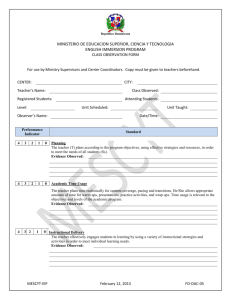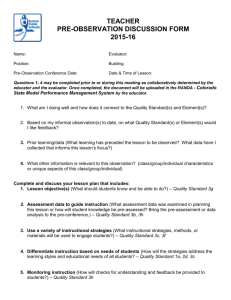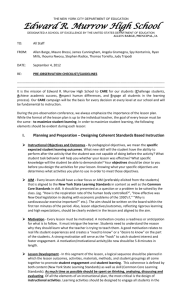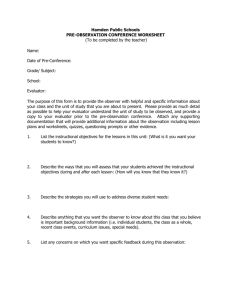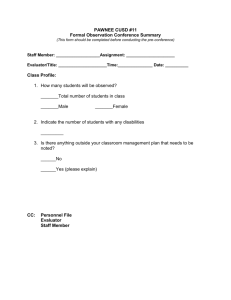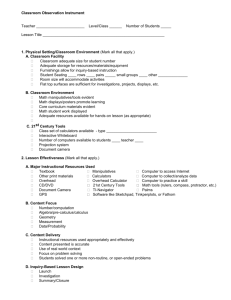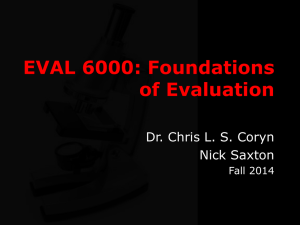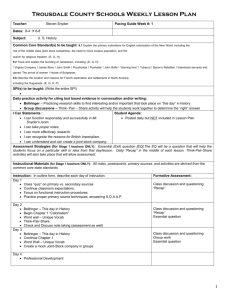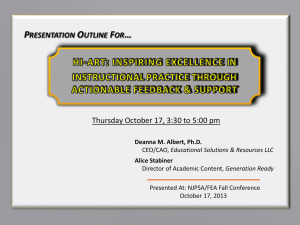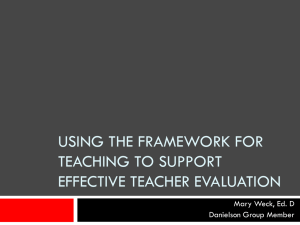FACILITATORSPPTFORTESSTRAINING
advertisement
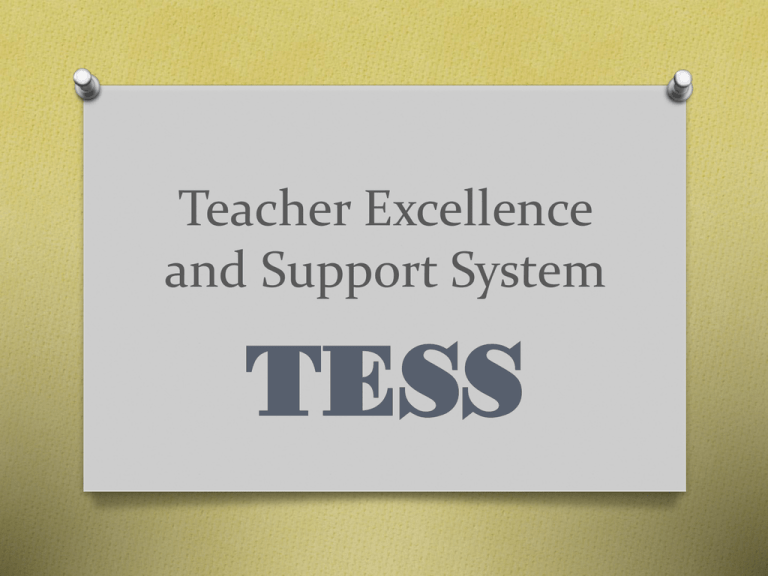
Teacher Excellence and Support System TESS Eliminating Bias “Evidence-based Evaluations Stereotyping Bias can affect evaluations IF evaluators fail to recognize and respond to their own personal stereotyping tendencies and are not required to provide real evidence. For example: O If an evaluator tends to stereotype young workers as lazy, he may be more likely to give these youthful employees negative evaluations, regardless of their actual level of industriousness. O If an evaluator considers technology skills to be extremely valuable, or impressive, he may be more likely to give a higher overall evaluation to those who are most proficient in that area. Halo Effect The halo effect refers to a person's tendency to allow his initial impression of a person to color his future interactions with this individual. The first impression that a person receives is often the longest-lasting . When this effect is in play, it can be challenging for workers to modify the ways the evaluator perceives them after this most important first impression. Fortunately, evidence-based evaluation systems do not rely on impressions! Similar-to-Me Errors Sometimes, evaluators are tempted to rate individuals to whom they feel similar more highly than those from whom they feel different. (teachers from the evaluator’s own subject area). Bias, Interpretation, or Evidence? 1.___The teacher had groups in tables facing each other and it made the room so noisy. Straight rows is a better arrangement for this type of activity 2.___The students were seated in rows and the first person got all supplies for their row and took up papers. 3.___The teacher greeted everyone at the door by name as they entered, but the students didn’t seem to care about that at all. 4.___The teacher was dressed too casually to be taken seriously. 5.___Teacher teased the students too much. Planning and Preparation Domain 1 Six Components of Planning O Knowing your content and pedagogy O Knowing your students O Knowing what materials are available O Setting instructional outcomes O Designing instruction purposefully O Designing assessments purposefully Teachers who “KNOW” their content… O Understand the way their discipline is structured O Is highly aware of pre-requisite relationships O Understands pedagogy related to his/her content Knowledge of Students Means… O Awareness of skill levels of students O Awareness of how particular students learn best O Understanding of students’ culture and interests O Understanding of child development Resource Knowledge Means… O The teacher chooses materials that are appropriately challenging O Materials uses match instructional outcomes O The teacher has access to materials that increase his/her professional learning Setting Instructional Outcomes Includes… O Balancing knowledge, conceptual understanding, and critical thinking O Making the learning objectives clear to students O Consideration of appropriateness of the learning Designing Instruction Includes… O Purposeful planning for student engagement O Planning for grouping situations that support the learning O Clear lesson and unit sequencing Assessment Design… O Learning expectations are clear O The teacher checks for understanding throughout instruction O Knowledge of how well students are understanding the concept/skill guides planning for the future Classroom Environment Domain 2 Five Components of Environment O Creating Respect and Rapport O Culture for Learning O Managing Procedures O Managing Behavior O Physical Space In a Respectful Environment… 1. The teacher’s interactions with students are positive and appropriate 2. The students show respect to the teacher 3. The student to student interaction is positive To Establish a Culture for Learning… 1. The teacher makes the importance of the content clear to the students 2. The teacher has obvious expectations for learning and achievement— classroom is business-like 3. Students have pride in their work For Effective Classroom Procedural Management… 1. Instructional groups are handled well 2. Transitions between activities are smooth and fairly quick 3. Materials and supplies are easily accessed 4. Non-instructional duties don’t interfere * Supervision of paraprofessionals In Effective Management of Student Behaviors… 1. The teacher makes the expectations clear 2. The teacher monitors the classroom 3. The teacher responds appropriately when misbehaviors occur Layers of Environment Behavior Procedures Learning is THE Priority Respect Instruction Domain 3 Five Components of Instruction O Communicating with Students O Using Questioning and Discussion Techniques O Engaging Students in Learning O Using Assessment in Instruction O Demonstrating Flexibility and Responsiveness Good Teacher Communication: 1. Sets the expectations for learning 2. Gives clear and thorough directions 3. Explains the content skillfully 4. Involves excellent written and oral language skills Questioning and Discussion Involves… 1. High quality questions 2. High levels of participation in responding to 3. 4. 5. 6. questions Appropriate wait time when questioning Cueing and prompting, as opposed to supplying the answers Use of effective discussion techniques Student to student talk, as well as whole class discussions Student Engagement is indicated by… 1. Student enthusiasm for the work (variety and 2. 3. 4. 5. choice) Activities and assignments that are relevant and worth doing Variety in class structure (whole group, small, individual) Variety of materials and resources Appropriate structure and pacing of the lesson To Use Assessment in Instruction… 1. The criteria for evaluation must be clear to the students 2. Teachers must be constantly monitoring student learning 3. Feedback is given frequently 4. Students self-assess frequently, as well Components of Instruction Questioning and Discussion Communication Assessment Engagement Professional Responsibilities Domain 4 Components of Professional Responsibilities O Reflection O Maintaining accurate records O Communication with families O Participation in professional community O Professional growth and development O Showing professionalism Reflection Should… O Be accurate (correspond to what would be given externally and specific examples from the lesson can be given to support) O Be used in future teaching— adjustments in practices are made Record Maintenance Includes… O Routines and systems that track completion of work O Information systems regarding student progress O Processes for keeping noninstructional information Communication with Families should … O Focus on the instructional program and student progress O Be frequent O Address individual students progress O Provide opportunity for family engagement in the learning process Participation in a Professional Learning Community Includes… a professional relationship with colleagues that includes sharing and planning O Being an active member of a “learning” community O Providing service to the school beyond the classroom O School and district projects O Professional Growth… O Enhancing content knowledge and pedagogy O Receptivity to feedback from colleagues O Service to the profession Professional Behavior O Ethical conduct O Service to students “putting students first” O Advocacy O Sound decision making O Compliance with district regulations
